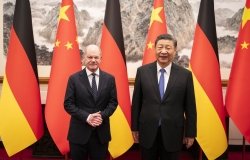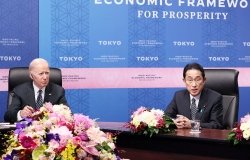Addicted? Assessing India's Growing Dependence on Energy Resources Abroad
With limited energy reserves at home, India is increasingly looking abroad to satisfy much of this voracious demand. The Asia Program, with assistance from the Global Energy Initiative, hosts a panel discussion on India's external energy security policy.
Overview
India boasts one of the world's fastest growing economies. Accompanying this growth is a rapidly increasing demand for energy. India is currently the world's fifth largest energy consumer, and is expected to vault to third place by 2030—behind only the United States and China. Because of limited energy reserves at home, India is increasingly looking abroad to satisfy much of this voracious demand. On July 22, the Asia Program, with assistance from the Global Energy Initiative, hosted a panel discussion on India's external energy security policy.
Tanvi Madan offered an overview of India's international energy strategy. The plan involves acquiring upstream assets; pursuing transnational pipeline projects; expanding bilateral supply contracts; procuring new technologies; and securing foreign investment. New Delhi's energy diplomacy extends from Central Asia to the Middle East, Africa, and Latin America, and has yielded various bilateral agreements and memorandums of understanding. Meanwhile, India's national oil companies (NOCs) negotiate for energy access and development privileges around the world. Madan noted that these firms are sometimes accused of "exploiting concern" about energy insecurity to benefit their bottom lines. In response, the New Delhi government has sought to ensure that NOCs not only make profits, but also contribute to the economic development of the countries in which they have a presence.
Juli MacDonald discussed how India's overseas energy strategy relates to its foreign policy goals. In essence, energy plays an enabling role in many of the country's strategic relationships. While energy is "not the primary driver" of these relationships, MacDonald argued, it nonetheless "helps deliver other strategic or political interests." For example, for New Delhi, the proposed U.S.-India nuclear deal is less about energy security—the nuclear fuel it would provide would fall far short of meeting India's soaring energy demand—and more about strengthening strategic ties with Washington. Similarly, India covets a "more tightly knit" relationship with Saudi Arabia—and attracting Saudi investment for local energy projects in India helps bring the countries closer together.
How does India's global search for energy affect the U.S.-India relationship? According to Mikkal Herberg, it generates several "vexing issues" for Washington-New Delhi ties. One is India's energy interests in Iran, Sudan, Burma, and Cuba. Another is what Washington perceives as India's pursuit of a "mercantilist" strategy—a determined quest "to lock up" energy deals with anyone, and by any means. India is seen as emphasizing ownership of energy resources instead of access to them—a violation of the market principles the United States seeks to uphold in the global energy realm. However, despite these troublesome factors, Herberg asserted that Washington is actually quite supportive of India's overseas energy strategy, and often critical of China's—which is very similar to India's. Herberg listed several reasons for this U.S. imbalance. One is that China's oil spending trumps India's by a 6 to 1 ratio. Another reason is ideological; talk about China's rising energy profile gets caught up in larger "China rising" fears. Finally, India's overseas energy policies dovetail with U.S. strategic interests, because India's "energy rise" is regarded as a "possible counterweight" to China.
Ron Somers reviewed India's domestic energy options. The country's two major resources are hydro and coal. Both, however, face obstacles. Hydroelectric development has caused the displacement of many Indians and led to much "public interest litigation." Coal, in addition to posing an environmental nightmare, presents logistical challenges. It is mostly found in eastern India, far from city centers, and transporting it to urban areas is difficult. On the brighter side, Somers identified some recently discovered indigenous gas and oil reserves—30 trillion feet of natural gas found in the Bay of Bengal in 2003, and oil deposits uncovered in western India in 2004. He suggested that India's future oil and gas needs will be better served by these local reserves than by potential pipeline deals with Pakistan and Iran, and (separately) with Turkmenistan, Afghanistan, and Pakistan—such transnational efforts, he argued, are fraught with too much political baggage to succeed.
All four speakers highlighted India's energy-driven close ties with some of the world's most repressive regimes. Yet the panel was unanimous that India has no intention of altering these relationships. When the West criticizes India for cozying up to the world's Burmas and Irans, Madan explained, New Delhi simply responds that the West is practicing a double standard. Indeed, Somers pointed out that Chevron, the U.S. oil giant, conducts business in Burma.
Drafted by Michael Kugelman.
Speakers
Hosted By

Indo-Pacific Program
The Indo-Pacific Program promotes policy debate and intellectual discussions on US interests in the Asia-Pacific as well as political, economic, security, and social issues relating to the world’s most populous and economically dynamic region. Read more

Environmental Change and Security Program
The Environmental Change and Security Program (ECSP) explores the connections between environmental change, health, and population dynamics and their links to conflict, human insecurity, and foreign policy. Read more
Thank you for your interest in this event. Please send any feedback or questions to our Events staff.











